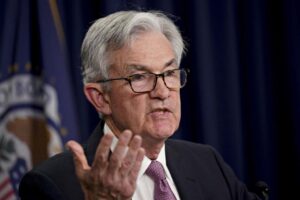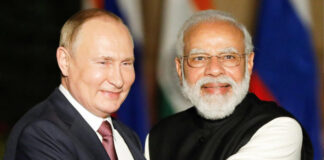JUNE 15, 2022

Jerome H. Powell, chairman of the U.S. Federal Reserve, speaks during a news conference following a Federal Open Market Committee meeting in D.C. on May 4. (Bloomberg News)
The Federal Reserve on Wednesday hiked interest rates by three quarters of a percentage point, its most aggressive move yet to try to control inflation, as it squeezes the U.S. economy.
The Fed has not enacted a hike of this size since 1994, but signaled similarly-large hikes are coming later this year.
For weeks, Fed leaders set expectations for an increase of half a percentage point, as it did in May, in the latest of seven rate increases slated for this year. But a surprisingly bleak inflation report released last week, the war in Ukraine plus growing signs that the markets and American public have lost faith in the Fed, ignited a more forceful push from central bank policymakers as they wrapped up two days of meetings.
“The invasion of Ukraine by Russia is causing tremendous human and economic hardship,” according to a statement released by Fed policymakers at the conclusion of the Fed’s two-day policy meeting. “The invasion and related events are creating additional upward pressure on inflation and are weighing on global economic activity. In addition, covid-related lockdowns in China are likely to exacerbate supply chain disruptions.”
The Fed added that it expects “ongoing increases” of three quarters of a percentage point “will be appropriate,” though it is unclear exactly how many, or at which meetings the Fed will implement them. (Kansas City Fed President Esther George voted against the rate decision, preferring a small hike of half a percentage point.)
The move to hike interest rates will make the price of mortgages, auto loans and a wide array of business investments more expensive. Rising interest rates work to cool off an overheated economy by dampening consumer spending, so that demand for goods and services falls, helping bring prices down. However, investors and some businesses are newly concerned that the move to get inflation under control could cool the economy too much, triggering a new recession and a wave of layoffs.
Federal Reserve Chair Jerome H. Powell will appear at a news conference at 2:30 p.m. Eastern time. He will be questioned about his confidence that the Fed’s plans will work and that policymakers can avoid a recession, especially given the delay to tackle inflation.
In May, prices climbed 8.6 percent compared with a year earlier, a new pandemic-era high. Soaring energy, housing and food prices continue to drive up costs at the fastest pace in 40 years, and Americans are feeling the strain in practically every part of their daily lives, from groceries to gas to rent.
Meanwhile, the markets fell this week as investors worried that the Fed was up to the task of slashing inflation. On Monday, the S&P 500 tumbled nearly 4 percent to cross into a bear market — meaning the index has lost 20 percent of its value since its most recent peak. So far in 2022, losses have wiped out a hefty chunk of the stock market’s pandemic-era gains.
The Fed is also fighting to regain the trust of American households and businesses worried that their costs of living will not go down anytime soon. Consumer sentiment in June sank to a low not seen since the 1980 recession, according to a University of Michigan survey released last week. Additionally, a poll by The Washington Post and George Mason University’s Schar School of Policy and Government found that most Americans expect inflation to worsen and are adjusting their spending habits, a mind-set that can make the surge in prices even worse.
Meanwhile, rising prices are weighing heavily on President Biden’s approval ratings and hampering his economic message at a time when many Americans do not feel like the economy is working for them. Republicans are also poised to hammer Democrats on inflation going into the midterms later this year.
Fed officials are under pressure to lower inflation and slow the hiring without causing people to lose their jobs. But the Fed cannot do that with any sort of precision. Plus, executing that plan will be exceedingly difficult. Indeed, a new crop of economic projections released at the end of Wednesday’s meeting pointed to a rising unemployment rate, lower economic growth and inflation that takes longer to fall.
The Fed also has a slightly weaker outlook on the U.S. economy for later this year. New Fed projections released today showed the unemployment rate rising, ticking up to 3.7 percent by the end of the year, 3.9 percent in 2023, and 4.1 percent by the end of 2024. That’s higher than the outlook back in March.
Also, the Fed had a more dour look at inflation levels later this year. They are predicting inflation to come down to about 5.2 percent, using their preferred gauge of measuring inflation, which is higher than their earlier estimates.
Fed officials also downgraded this year’s economic growth estimates to 1.7 percent.
The repercussions of rising inflation are playing out globally. Policymakers from the European Central Bank held a rare unscheduled meeting Wednesday to address higher borrowing costs for many European governments and address fears of a debt crisis.
Now, the Fed faces the enormous task of squashing inflation without damaging the rest of the economy, which has been booming, especially for workers. The Fed’s leaders hope that interest rate hikes will slow demand for workers and help get the labor market — which has about two job openings for each person looking for work — back on a more sustainable path.
But the Fed cannot slow the economy with much precision. If policymakers move too abruptly, they can trigger a sudden economic downturn, risking job losses and sending the country into recession.
On top of it all, it’s unclear whether a steady stream of Fed rate hikes will be a match for the kind of inflation dogging The Post-pandemic economy. In an encouraging sign, the red-hot housing market has started to cool, as a run-up in mortgage rates discourage aspiring buyers from competing for the few homes available.
One big driver of inflation is energy and gas prices, which surged since Russia’s February invasion of Ukraine. Supply chain issues continue to push up prices for cars and construction materials. Ultimately, rate hikes can’t address semiconductor shortages or end a war, nor can they assuage peoples’ anxiety about paying a national average of $5 per gallon — if not more — at the gas pump.
The Fed noted there was one vote against the move to hike rates by three-quarters of a percentage point — Esther George said she preferred to raise the target range for the federal funds rate by 0.5 percentage point.

































































































